picoctf2019-writeup
picoCTF2019 writeup
Project maintained by johantannh Hosted on GitHub Pages — Theme by mattgraham
vault-door-training
Points: 50
Problem
Your mission is to enter Dr. Evil’s laboratory and retrieve the blueprints for his Doomsday Project. The laboratory is protected by a series of locked vault doors. Each door is controlled by a computer and requires a password to open. Unfortunately, our undercover agents have not been able to obtain the secret passwords for the vault doors, but one of our junior agents obtained the source code for each vault’s computer! You will need to read the source code for each level to figure out what the password is for that vault door. As a warmup, we have created a replica vault in our training facility. The source code for the training vault is here: VaultDoorTraining.java
Hint
The password is revealed in the program’s source code.
Solution
Password can be found within the checkPassword method. The password entered would just be used to compare with the password set within the checkPassword method. Hence the flag is ‘w4rm1ng_Up_w1tH_jAv4_87f51143e4b’.
public boolean checkPassword(String password) {
return password.equals("w4rm1ng_Up_w1tH_jAv4_87f51143e4b");
}
Flag
picoCTF{w4rm1ng_Up_w1tH_jAv4_87f51143e4b}
vault-door-1
Points: 100
Problem
This vault uses some complicated arrays! I hope you can make sense of it, special agent. The source code for this vault is here: VaultDoor1.java
Hint
Look up the charAt() method online.
Solution
Same as the previous task, the password is within the checkPassword method. Upon looking up the source code for the vaultDoor1.java, the new checkPassword method tries to scan each character of the password input into the program. The sequence and the indexing of the password are obfuscated to increase the difficulty of decoding the password.
Length of Password = 32.
public boolean checkPassword(String password) {
return password.length() == 32 &&
password.charAt(0) == 'd' &&
password.charAt(29) == 'f' &&
password.charAt(4) == 'r' &&
password.charAt(2) == '5' &&
password.charAt(23) == 'r' &&
password.charAt(3) == 'c' &&
password.charAt(17) == '4' &&
password.charAt(1) == '3' &&
password.charAt(7) == 'b' &&
password.charAt(10) == '_' &&
password.charAt(5) == '4' &&
password.charAt(9) == '3' &&
password.charAt(11) == 't' &&
password.charAt(15) == 'c' &&
password.charAt(8) == 'l' &&
password.charAt(12) == 'H' &&
password.charAt(20) == 'c' &&
password.charAt(14) == '_' &&
password.charAt(6) == 'm' &&
password.charAt(24) == '5' &&
password.charAt(18) == 'r' &&
password.charAt(13) == '3' &&
password.charAt(19) == '4' &&
password.charAt(21) == 'T' &&
password.charAt(16) == 'H' &&
password.charAt(27) == '3' &&
password.charAt(30) == '3' &&
password.charAt(25) == '_' &&
password.charAt(22) == '3' &&
password.charAt(28) == 'e' &&
password.charAt(26) == '6' &&
password.charAt(31) == 'a';
}
To retrieve the password,
- Method 1 : Either run the same code on a new console application, replace ‘password.chartAt(‘ with a temp variables
- Method 2 : Use notepad++ with line operation to re-arrange the lines according to the index number to retreive the flag for this problem.
Run Code Via IDE Method 1
class Main {
public static void main(String[] args) {
printPassword();
}
public static void printPassword(){
char[] temp = new char[32];
temp[0] = 'd';
temp[29] = 'f';
temp[4] = 'r';
temp[2] = '5';
temp[23] = 'r';
temp[3] = 'c';
temp[17] = '4';
temp[1] = '3';
temp[7] = 'b';
temp[10] = '_';
temp[5] = '4';
temp[9] = '3';
temp[11] = 't';
temp[15] = 'c';
temp[8] = 'l';
temp[12] = 'H';
temp[20] = 'c';
temp[14] = '_';
temp[6] = 'm';
temp[24] = '5';
temp[18] = 'r';
temp[13] = '3';
temp[19] = '4';
temp[21] = 'T';
temp[16] = 'H';
temp[27] = '3';
temp[30] = '3';
temp[25] = '_';
temp[22] = '3';
temp[28] = 'e';
temp[26] = '6';
temp[31] = 'a';
String t = "picoCTF{";
for (char x : temp){
t += x;
}
t += "}";
System.out.println(t);
}
}
Arrange Using Notepad++ & Excel Method 2
Flag
picoCTF{d35cr4mbl3_tH3_cH4r4cT3r5_63ef3a}
vault-door-3
Points: 200
Problem
This vault uses for-loops and byte arrays. The source code for this vault is here: VaultDoor3.java
Hint
Make a table that contains each value of the loop variables and the corresponding buffer index that it writes to.
Solution Here
Process of Encryption
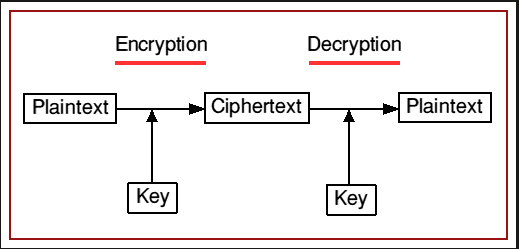
import java.util.Scanner;
class Main {
static String CipherText = "jU5t_a_sna_3lpm13gc49_u_4_m0rf41";
public static void main(String[] args) {
System.out.println("Cipher password: " + CipherText);
String pass = reversePassword(CipherText);
String userInput = "picoCTF{" + pass + "}";
System.out.println("Enter password: " + userInput);
String input = userInput.substring("picoCTF{".length(), userInput.length() - 1);
if (checkPassword(input)) {
System.out.println("Access granted.");
} else {
System.out.println("Access denied!");
}
}
public static boolean checkPassword(String password) {
char[] buffer = new char[32];
int i;
if (password.length() != 32) {
return false;
}
for (i = 0; i < 8; i++) {
buffer[i] = password.charAt(i);
}
for (; i < 16; i++) {
buffer[i] = password.charAt(23 - i);
}
for (; i < 32; i += 2) {
buffer[i] = password.charAt(46 - i);
}
for (i = 31; i >= 17; i -= 2) {
buffer[i] = password.charAt(i);
}
String s = new String(buffer);
return s.equals("jU5t_a_sna_3lpm13gc49_u_4_m0rf41");
}
public static String reversePassword(String password) {
char[] buffer = new char[32];
int i;
for (i = 0; i < 8; i++) {
buffer[i] = password.charAt(i);
}
for (; i < 16; i++) {
buffer[i] = password.charAt(23 - i);
}
for (; i < 32; i += 2) {
buffer[i] = password.charAt(46 - i);
}
for (i = 31; i >= 17; i -= 2) {
buffer[i] = password.charAt(i);
}
return new String(buffer);
}
}
Flag
picoCTF{jU5t_a_s1mpl3_an4gr4m_4_u_90cf31}
Cipher password: jU5t_a_sna_3lpm13gc49_u_4_m0rf41
Enter password: picoCTF{jU5t_a_s1mpl3_an4gr4m_4_u_90cf31}
Access granted.
vault-door-4
Points: 250
Problem
This vault uses ASCII encoding for the password. The source code for this vault is here: VaultDoor4.java
Hint
Use a search engine to find an “ASCII table”.
You will also need to know the difference between octal, decimal, and hexademical numbers.
Solution Here
public static boolean checkPassword(String password) {
byte[] passBytes = password.getBytes();
byte[] myBytes = {
106, 85, 53, 116, 95, 52, 95, 98,
0x55, 0x6e, 0x43, 0x68, 0x5f, 0x30, 0x66, 0x5f,
0142, 0131, 0164, 063, 0163, 0137, 063, 0141,
'7', '2', '4', 'c', '8', 'f', '9', '2',
};
/*
Password is within myBytes. Just convert them from decimal,
hex, octal to ASCII. This will result in
decimal : 106, 85, 53, 116, 95, 52, 95, 98 >> jU5t_4_b
hex : 0x55, 0x6e, 0x43, 0x68, 0x5f, 0x30, 0x66, 0x5f >> UnCh_0f_
oct : 0142, 0131, 0164, 063, 0163, 0137, 063, 0141 >> bYt3s_3a (convert decimal then hex)
ASCII : '7', '2', '4', 'c', '8', 'f', '9', '2' >> 724c8f92
Combine : jU5t_4_bUnCh_0f_bYt3s_3a724c8f92
https://www.rapidtables.com/convert/number/ascii-hex-bin-dec-converter.html
*/
for (int i = 0; i < 32; i++) {
if (passBytes[i] != myBytes[i]) {
return false;
}
}
return true;
}
Flag
picoCTF{jU5t_4_bUnCh_0f_bYt3s_3a724c8f92}
vault-door-5
Points: 300
Problem
In the last challenge, you mastered octal (base 8), decimal (base 10), and hexadecimal (base 16) numbers, but this vault door uses a different change of base as well as URL encoding! The source code for this vault is here: VaultDoor5.java
Hint
You may find an encoder/decoder tool helpful, such as https://encoding.tools/
Read the wikipedia articles on URL encoding and base 64 encoding to understand how they work and what the results look like.
Solution Here
import java.net.URLDecoder;
import java.util.*;
import java.nio.charset.StandardCharsets;
import java.io.UnsupportedEncodingException;
class Main {
public static String expected =
"JTYzJTMwJTZlJTc2JTMzJTcyJTc0JTMxJTZlJTY3JTVm"
+ "JTY2JTcyJTMwJTZkJTVmJTYyJTYxJTM1JTY1JTVmJTM2"
+ "JTM0JTVmJTY0JTYxJTM4JTM4JTMyJTY0JTMwJTMx";
public static void main(String[] args) {
//Encode from URL > Base 64
//Decode from Base 64 > URL
System.out.println("Expected : " + expected);
String b64d = base64Decode(expected);
System.out.println("Expected URL : " + b64d.toString());
String urlDecoded = urlDecode(b64d);
System.out.println("Expected password : " + urlDecoded);
String userInput = "picoCTF{" + urlDecoded + "}";
System.out.println("Enter vault password: " + userInput);
String input = userInput.substring("picoCTF{".length(), userInput.length() - 1);
if (checkPassword(input)) {
System.out.println("Access granted.");
} else {
System.out.println("Access denied!");
}
}
// Minion #7781 used base 8 and base 16, but this is base 64, which is
// like... eight times stronger, right? Riiigghtt? Well that's what my twin
// brother Minion #2415 says, anyway.
//
// -Minion #2414
public static String base64Encode(byte[] input) {
return Base64.getEncoder().encodeToString(input);
}
public static String base64Decode(String input) {
byte[] bytes = Base64.getDecoder().decode(input);
String s = new String(bytes);
return s;
}
// URL encoding is meant for web pages, so any double agent spies who steal
// our source code will think this is a web site or something, defintely not
// vault door! Oh wait, should I have not said that in a source code
// comment?
//
// -Minion #2415
public static String urlEncode(byte[] input) {
StringBuffer buf = new StringBuffer();
for (int i = 0; i < input.length; i++) {
buf.append(String.format("%%%2x", input[i]));
}
return buf.toString();
}
public static String urlDecode(String urlString) {
try {
return URLDecoder.decode(urlString, StandardCharsets.UTF_8.toString());
} catch (UnsupportedEncodingException ex) {
throw new RuntimeException(ex.getCause());
}
}
public static boolean checkPassword(String password) {
String urlEncoded = urlEncode(password.getBytes());
String base64Encoded = base64Encode(urlEncoded.getBytes());
return base64Encoded.equals(expected);
}
}
Flag
picoCTF{c0nv3rt1ng_fr0m_ba5e_64_da882d01}
Expected : JTYzJTMwJTZlJTc2JTMzJTcyJTc0JTMxJTZlJTY3JTVmJTY2JTcyJTMwJTZkJTVmJTYyJTYxJTM1JTY1JTVmJTM2JTM0JTVmJTY0JTYxJTM4JTM4JTMyJTY0JTMwJTMx
Expected URL : %63%30%6e%76%33%72%74%31%6e%67%5f%66%72%30%6d%5f%62%61%35%65%5f%36%34%5f%64%61%38%38%32%64%30%31
Expected password : c0nv3rt1ng_fr0m_ba5e_64_da882d01
Enter vault password: picoCTF{c0nv3rt1ng_fr0m_ba5e_64_da882d01}
Access granted.
vault-door-6
Points: 350
Problem
This vault uses an XOR encryption scheme. The source code for this vault is here: VaultDoor6.java
Hint
If X ^ Y = Z, then Z ^ Y = X. Write a program that decrypts the flag based on this fact.
Solution Here
class Main {
public static byte[] myBytes = {
0x3b, 0x65, 0x21, 0x0a, 0x38, 0x00 , 0x36, 0x1d,
0x0a, 0x3d, 0x61, 0x27, 0x11, 0x66, 0x27, 0x0a,
0x21, 0x1d, 0x61, 0x3b, 0x0a , 0x2d, 0x65, 0x27,
0x0a, 0x66, 0x61, 0x6d, 0x61, 0x30, 0x37, 0x36,
};
public static void main(String[] args) {
String s = new String(myBytes);
System.out.println("Pre Reverse Password Converted From Bytes : " + s.replaceAll("[\\n\\r]", ""));
byte[] myPassBytes = new byte[32];
byte byte_operand = 0x55;
int i = 0;
for (byte b : myBytes) {
myPassBytes[i] = (byte) ((int) b ^ (int) byte_operand);
i++;
}
String userInput = "picoCTF{";
userInput += new String(myPassBytes).replaceAll("[\\n\\r]", "");
userInput +="}";
System.out.println("Reverse Password: " + userInput);
System.out.println("Enter vault password:" + userInput);
String input = userInput.substring("picoCTF{".length(), userInput.length() -
1);
if (checkPassword(input)) {
System.out.println("Access granted.");
} else {
System.out.println("Access denied!");
}
}
public static boolean checkPassword(String password) {
if (password.length() != 32) {
return false;
}
byte[] passBytes = password.getBytes();
/*
* Encryption part is within this loop, where every byte is XOR with the
* password to check if it match.
*
* Since X ^ Y = Z, then Z ^ Y = X.
*
*/
for (int i = 0; i < 32; i++) {
if (((passBytes[i] ^ 0x55) - myBytes[i]) != 0) {
return false;
}
}
return true;
}
}
Flag
picoCTF{n0t_mUcH_h4rD3r_tH4n_x0r_3484ebc}
Pre Reverse Password Converted From Bytes : ;e!86
=a'f'!
a;-e'fama076
Reverse Password: picoCTF{n0t_mUcH_h4rD3r_tH4n_x0r_3484ebc}
Enter vault password:picoCTF{n0t_mUcH_h4rD3r_tH4n_x0r_3484ebc}
Access granted.
vault-door-7
Points: 400
Problem
This vault uses bit shifts to convert a password string into an array of integers. Hurry, agent, we are running out of time to stop Dr. Evil’s nefarious plans! The source code for this vault is here: VaultDoor7.java
Hint
Use a decimal/hexademical converter such as this one: https://www.mathsisfun.com/binary-decimal-hexadecimal-converter.html
You will also need to consult an ASCII table such as this one: https://www.asciitable.com/
Solution Here
import java.util.*;
import javax.crypto.Cipher;
import javax.crypto.spec.SecretKeySpec;
import java.security.*;
class Main {
public static void main(String args[]) {
String userInput = "picoCTF{";
userInput += breakPassword();
userInput += "}";
System.out.println("Reverse Password: " + userInput);
System.out.println("Enter vault password: " + userInput);
String input = userInput.substring("picoCTF{".length(), userInput.length() - 1);
if (checkPassword(input)) {
System.out.println("Access granted.");
} else {
System.out.println("Access denied!");
}
}
// Each character can be represented as a byte value using its
// ASCII encoding. Each byte contains 8 bits, and an int contains
// 32 bits, so we can "pack" 4 bytes into a single int. Here's an
// example: if the hex string is "01ab", then those can be
// represented as the bytes {0x30, 0x31, 0x61, 0x62}. When those
// bytes are represented as binary, they are:
//
// 0x30: 00110000
// 0x31: 00110001
// 0x61: 01100001
// 0x62: 01100010
//
// If we put those 4 binary numbers end to end, we end up with 32
// bits that can be interpreted as an int.
//
// 00110000001100010110000101100010 -> 808542562
//
// Since 4 chars can be represented as 1 int, the 32 character password can
// be represented as an array of 8 ints.
//
// - Minion #7816
public static int[] passwordToIntArray(String hex) {
int[] x = new int[8];
byte[] hexBytes = hex.getBytes();
for (int i = 0; i < 8; i++) {
x[i] = hexBytes[i * 4] << 24 | hexBytes[i * 4 + 1] << 16 | hexBytes[i * 4 + 2] << 8 | hexBytes[i * 4 + 3];
}
return x;
}
public static boolean checkPassword(String password) {
if (password.length() != 32) {
return false;
}
int[] x = passwordToIntArray(password);
return x[0] == 1096770097 // 0x415F6231 = 01000001 01011111 01100010 00110001
&& x[1] == 1952395366 // 0x745F3066 = 01110100 01011111 00110000 01100110
&& x[2] == 1600270708 // 0x5F623174 = 01011111 01100010 00110001 01110100
&& x[3] == 1601398833 // 0x5F736831 = 01011111 01110011 01101000 00110001
&& x[4] == 1716808014 // 0x6654694E = 01100110 01010100 01101001 01001110
&& x[5] == 1734293815 // 0x675F3937 = 01100111 01011111 00111001 00110111
&& x[6] == 1667379558 // 0x63623166 = 01100011 01100010 00110001 01100110
&& x[7] == 859191138; // 0x33363762 = 00110011 00110110 00110111 01100010
}
//Reverse the password by first converting the int > hex > ASCII
//Append the bits of the password by using string builder
public static String breakPassword() {
int[] x = new int[8];
x[0] = 1096770097;
x[1] = 1952395366;
x[2] = 1600270708;
x[3] = 1601398833;
x[4] = 1716808014;
x[5] = 1734293815;
x[6] = 1667379558;
x[7] = 859191138;
StringBuilder cOutput = new StringBuilder("");
for (int temp : x) {
String decrypted = hexToAscii(Integer.toHexString(temp));
cOutput.append(decrypted);
}
return cOutput.toString();
}
private static String hexToAscii(String hexStr) {
StringBuilder output = new StringBuilder("");
for (int i = 0; i < hexStr.length(); i += 2) {
String str = hexStr.substring(i, i + 2);
output.append((char) Integer.parseInt(str, 16));
}
return output.toString();
}
}
Flag
picoCTF{A_b1t_0f_b1t_sh1fTiNg_97cb1f367b}
Reverse Password: picoCTF{A_b1t_0f_b1t_sh1fTiNg_97cb1f367b}
Enter vault password: picoCTF{A_b1t_0f_b1t_sh1fTiNg_97cb1f367b}
Access granted.
vault-door-8
Points: 450
Problem
Apparently Dr. Evil’s minions knew that our agency was making copies of their source code, because they intentionally sabotaged this source code in order to make it harder for our agents to analyze and crack into! The result is a quite mess, but I trust that my best special agent will find a way to solve it. The source code for this vault is here: VaultDoor8.java
Hint
Clean up the source code so that you can read it and understand what is going on.
Draw a diagram to illustrate which bits are being switched in the scramble() method, then figure out a sequence of bit switches to undo it. You should be able to reuse the switchBits() method as is.
Solution Here
Code In Obfuscated Form.
// These pesky special agents keep reverse engineering our source code and then
// breaking into our secret vaults. THIS will teach those sneaky sneaks a
// lesson.
//
// -Minion #0891
import java.util.*; import javax.crypto.Cipher; import javax.crypto.spec.SecretKeySpec;
import java.security.*; class VaultDoor8 {public static void main(String args[]) {
Scanner b = new Scanner(System.in); System.out.print("Enter vault password: ");
String c = b.next(); String f = c.substring(8,c.length()-1); VaultDoor8 a = new VaultDoor8(); if (a.checkPassword(f)) {System.out.println("Access granted."); }
else {System.out.println("Access denied!"); } } public char[] scramble(String password) {/* Scramble a password by transposing pairs of bits. */
char[] a = password.toCharArray(); for (int b=0; b<a.length; b++) {char c = a[b]; c = switchBits(c,1,2); c = switchBits(c,0,3); /* c = switchBits(c,14,3); c = switchBits(c, 2, 0); */ c = switchBits(c,5,6); c = switchBits(c,4,7);
c = switchBits(c,0,1); /* d = switchBits(d, 4, 5); e = switchBits(e, 5, 6); */ c = switchBits(c,3,4); c = switchBits(c,2,5); c = switchBits(c,6,7); a[b] = c; } return a;
} public char switchBits(char c, int p1, int p2) {/* Move the bit in position p1 to position p2, and move the bit
that was in position p2 to position p1. Precondition: p1 < p2 */ char mask1 = (char)(1 << p1);
char mask2 = (char)(1 << p2); /* char mask3 = (char)(1<<p1<<p2); mask1++; mask1--; */ char bit1 = (char)(c & mask1); char bit2 = (char)(c & mask2); /* System.out.println("bit1 " + Integer.toBinaryString(bit1));
System.out.println("bit2 " + Integer.toBinaryString(bit2)); */ char rest = (char)(c & ~(mask1 | mask2)); char shift = (char)(p2 - p1); char result = (char)((bit1<<shift) | (bit2>>shift) | rest); return result;
} public boolean checkPassword(String password) {char[] scrambled = scramble(password); char[] expected = {
0xF4, 0xC0, 0x97, 0xF0, 0x77, 0x97, 0xC0, 0xE4, 0xF0, 0x77, 0xA4, 0xD0, 0xC5, 0x77, 0xF4, 0x86, 0xD0, 0xA5, 0x45, 0x96, 0x27, 0xB5, 0x77, 0xE1, 0xC0, 0xA4, 0x95, 0x94, 0xD1, 0x95, 0x94, 0xD0 }; return Arrays.equals(scrambled, expected); } }
Code After Beautify
// These pesky special agents keep reverse engineering our source code and then
// breaking into our secret vaults. THIS will teach those sneaky sneaks a
// lesson.
//
// -Minion #0891
import java.util.*;
import javax.crypto.Cipher;
import javax.crypto.spec.SecretKeySpec;
import java.security.*;
class VaultDoor8 {
public static void main(String args[]) {
Scanner b = new Scanner(System.in);
System.out.print("Enter vault password: ");
String c = b.next();
String f = c.substring(8, c.length() - 1);
VaultDoor8 a = new VaultDoor8();
if (a.checkPassword(f)) {
System.out.println("Access granted.");
} else {
System.out.println("Access denied!");
}
}
public char[] scramble(String password) {
/* Scramble a password by transposing pairs of bits. */
char[] a = password.toCharArray();
for (int b = 0; b < a.length; b++) {
char c = a[b];
c = switchBits(c, 1, 2);
c = switchBits(c, 0, 3); /* c = switchBits(c,14,3); c = switchBits(c, 2, 0); */
c = switchBits(c, 5, 6);
c = switchBits(c, 4, 7);
c = switchBits(c, 0, 1); /* d = switchBits(d, 4, 5); e = switchBits(e, 5, 6); */
c = switchBits(c, 3, 4);
c = switchBits(c, 2, 5);
c = switchBits(c, 6, 7);
a[b] = c;
}
return a;
}
public char switchBits(char c, int p1, int p2) {
/* Move the bit in position p1 to position p2, and move the bit
that was in position p2 to position p1. Precondition: p1 < p2 */
char mask1 = (char)(1 << p1);
char mask2 = (char)(1 << p2); /* char mask3 = (char)(1<<p1<<p2); mask1++; mask1--; */
char bit1 = (char)(c & mask1);
char bit2 = (char)(c & mask2);
/* System.out.println("bit1 " + Integer.toBinaryString(bit1));
System.out.println("bit2 " + Integer.toBinaryString(bit2)); */
char rest = (char)(c & ~(mask1 | mask2));
char shift = (char)(p2 - p1);
char result = (char)((bit1 << shift) | (bit2 >> shift) | rest);
return result;
}
public boolean checkPassword(String password) {
char[] scrambled = scramble(password);
char[] expected = {
0xF4, 0xC0, 0x97, 0xF0, 0x77, 0x97, 0xC0, 0xE4,
0xF0, 0x77, 0xA4, 0xD0, 0xC5, 0x77, 0xF4, 0x86,
0xD0, 0xA5, 0x45, 0x96, 0x27, 0xB5, 0x77, 0xE1,
0xC0, 0xA4, 0x95, 0x94, 0xD1, 0x95, 0x94, 0xD0
};
return Arrays.equals(scrambled, expected);
}
}
After reversing the order of Scramble Method
// These pesky special agents keep reverse engineering our source code and then
// breaking into our secret vaults. THIS will teach those sneaky sneaks a
// lesson.
//
// -Minion #0891
import java.util.*;
import javax.crypto.Cipher;
import javax.crypto.spec.SecretKeySpec;
import java.security.*;
class Main {
public static void main(String[] args) {
String userInput = "picoCTF{";
userInput += String.valueOf(unScramble());
userInput += "}";
System.out.println("Reverse Password: " + userInput);
System.out.println("Enter vault password: " + userInput);
String input = userInput.substring("picoCTF{".length(), userInput.length() - 1);
if (checkPassword(input)) {
System.out.println("Access granted.");
} else {
System.out.println("Access denied!");
}
}
// reverse the order of the scramble methhod.
// E.g. 1>2>3>4>5 ===> 5>4>3>2>1
public static char[] unScramble() {
/* Scramble a password by transposing pairs of bits. */
// char[] a = password.toCharArray();
char[] expected = { 0xF4, 0xC0, 0x97, 0xF0, 0x77, 0x97, 0xC0, 0xE4, 0xF0, 0x77, 0xA4, 0xD0, 0xC5, 0x77, 0xF4, 0x86,
0xD0, 0xA5, 0x45, 0x96, 0x27, 0xB5, 0x77, 0xE1, 0xC0, 0xA4, 0x95, 0x94, 0xD1, 0x95, 0x94, 0xD0 };
for (int b = 0; b < expected.length; b++) {
char c = expected[b];
c = switchBits(c, 6, 7);
c = switchBits(c, 2, 5);
c = switchBits(c, 3, 4);
c = switchBits(c, 0, 1);
/* d = switchBits(d, 4, 5); e = switchBits(e, 5, 6); */
c = switchBits(c, 4, 7);
c = switchBits(c, 5, 6);
c = switchBits(c, 0, 3);
/* c = switchBits(c,14,3); c = switchBits(c, 2, 0); */
c = switchBits(c, 1, 2);
expected[b] = c;
}
return expected;
}
public static char[] scramble(String password) {
/* Scramble a password by transposing pairs of bits. */
char[] a = password.toCharArray();
for (int b = 0; b < a.length; b++) {
char c = a[b];
c = switchBits(c, 1, 2);
c = switchBits(c, 0, 3); /* c = switchBits(c,14,3); c = switchBits(c, 2, 0); */
c = switchBits(c, 5, 6);
c = switchBits(c, 4, 7);
c = switchBits(c, 0, 1); /* d = switchBits(d, 4, 5); e = switchBits(e, 5, 6); */
c = switchBits(c, 3, 4);
c = switchBits(c, 2, 5);
c = switchBits(c, 6, 7);
a[b] = c;
}
return a;
}
public static char switchBits(char c, int p1, int p2) {
/*
* Move the bit in position p1 to position p2, and move the bit that was in
* position p2 to position p1. Precondition: p1 < p2
*/
char mask1 = (char) (1 << p1);
char mask2 = (char) (1 << p2);
/* char mask3 = (char)(1<<p1<<p2); mask1++; mask1--; */
char bit1 = (char) (c & mask1);
char bit2 = (char) (c & mask2);
/*
* System.out.println("bit1 " + Integer.toBinaryString(bit1));
* System.out.println("bit2 " + Integer.toBinaryString(bit2));
*/
char rest = (char) (c & ~(mask1 | mask2));
char shift = (char) (p2 - p1);
char result = (char) ((bit1 << shift) | (bit2 >> shift) | rest);
return result;
}
public static boolean checkPassword(String password) {
char[] scrambled = scramble(password);
char[] expected = { 0xF4, 0xC0, 0x97, 0xF0, 0x77, 0x97, 0xC0, 0xE4, 0xF0, 0x77, 0xA4, 0xD0, 0xC5, 0x77, 0xF4, 0x86,
0xD0, 0xA5, 0x45, 0x96, 0x27, 0xB5, 0x77, 0xE1, 0xC0, 0xA4, 0x95, 0x94, 0xD1, 0x95, 0x94, 0xD0 };
return Arrays.equals(scrambled, expected);
}
}
Flag
picoCTF{s0m3_m0r3_b1t_sh1fTiNg_60bea5ea1}
Reverse Password: picoCTF{s0m3_m0r3_b1t_sh1fTiNg_60bea5ea1}
Enter vault password: picoCTF{s0m3_m0r3_b1t_sh1fTiNg_60bea5ea1}
Access granted.
asm1
Points: 200
Problem
What does asm1(0x345) return? Submit the flag as a hexadecimal value (starting with ‘0x’). NOTE: Your submission for this question will NOT be in the normal flag format. Source located in the directory at /problems/asm1_5_301df039c0ee4ee4dfa8adad6a40b875.
Hint
assembly conditions
Solution (2 Methods)
Example of the Stack during Subroutine Call
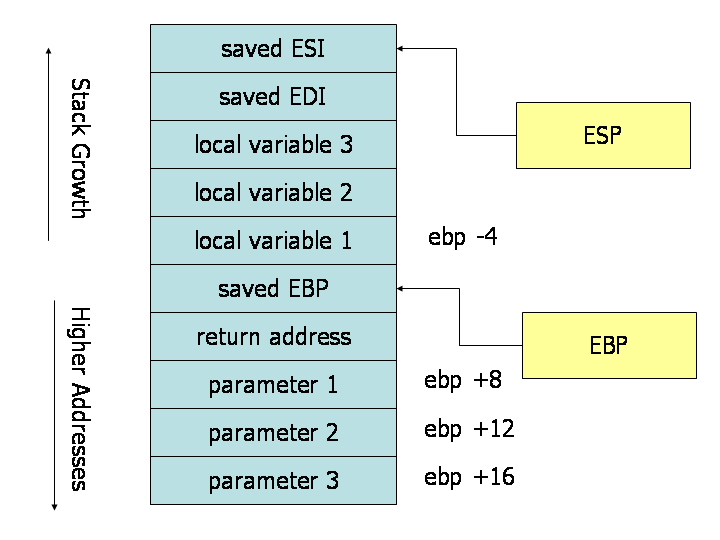
Method 1 : Visualising the questions.
Method 2 : Here
Calling asm1(0x345) >> move {0x345} into [ebp+08]
This is how the stack looks like after performing the mov ebp,esp command:
+---------------+
| old ebp | <-- ebp
+---------------+
| ret | <-- ebp + 0x4
+---------------+
| 0x345 | <-- ebp + 0x8 (arg1)
+---------------+
asm1: ; Description of Function
<+0>: push ebp ; function Prologue
<+1>: mov ebp,esp ; ~
<+3>: cmp DWORD PTR [ebp+0x8],0x37a; cmp - compare {0x345 vs 0x37a} = 345 < 37a (lesser than; therefore no jump)
<+10>: jg 0x512 <asm1+37> ; --------- JG - Jump Greater if true
; |
<+12>: cmp DWORD PTR [ebp+0x8],0x345; | cmp - compare {0x345 vs 0x345} = 345 = 345 (equal than; therefore no jump)
<+19>: jne 0x50a <asm1+29> ; --------|---------- JNE - Jump not Equal if true
; | ||
<+21>: mov eax,DWORD PTR [ebp+0x8] ; | || move [ebp+0x8] = {0x345} into EAX
<+24>: add eax,0x3 ; | || add 0x3 to EAX = {0x345 + 0x3} = {0x348} <<<< Correct Answer; no condition jump to {asm1+60}
<+27>: jmp 0x529 <asm1+60> ; --------|--------||-------------- JMP - Jump to address {asm1+60}
; | || v
<+29>: mov eax,DWORD PTR [ebp+0x8] ; <-----------|---------- v move [ebp+0x8] = {0x345} into EAX
<+32>: sub eax,0x3 ; | v sub 0x3 to EAX
<+35>: jmp 0x529 <asm1+60> ; --------|-----------------------v JMP - Jump to address {asm1+60}
; | v
<+37>: cmp DWORD PTR [ebp+0x8],0x5ff; <----------- v cmp - compare {0x345 vs 0x5ff}
<+44>: jne 0x523 <asm1+54> ; ----------------- v JNE - Jump not Equal if true
; | v
<+46>: mov eax,DWORD PTR [ebp+0x8] ; | v move [ebp+0x8] = {0x345} into EAX
<+49>: sub eax,0x3 ; | v sub 0x3 to EAX
<+52>: jmp 0x529 <asm1+60> ; ----------------|---------------v JMP - Jump to address {asm1+60}
; | v
<+54>: mov eax,DWORD PTR [ebp+0x8] ; <-------------------- v move [ebp+0x8] = {0x345} into EAX
<+57>: add eax,0x3 ; v add 0x3 to EAX
<+60>: pop ebp ; <------------------------------------ function Epilogue
<+61>: ret ; return
Flag
0x348
asm2
Points: 250
Problem
What does asm2(0x7,0x18) return? Submit the flag as a hexadecimal value (starting with ‘0x’). NOTE: Your submission for this question will NOT be in the normal flag format. Source located in the directory at /problems/asm2_3_edb10ce41667cb1cd4213657dae580fd.
Hint
assembly conditions
Solution
Method 1 : Visualising the questions.
Method 2 : Here
Calling asm2(0x7,0x18) >> move {0x7} into [ebp+08] & {0x18} into [ebp+0c]
This is how the stack looks like after performing the mov ebp,esp command & after operation :
'mov ebp,esp' | 'after operation'
+---------------+ | +---------------+
| reserve | <-- ebp - 0x10 | | reserve | <-- ebp - 0x10
+---------------+ | +---------------+
| reserve | <-- ebp - 0xc | | reserve | <-- ebp - 0xc
+---------------+ | +---------------+
| reserve | <-- ebp - 0x8 | | 0x3967 | <-- ebp - 0x8 (0x7 + [48 x 0xcc = 0x3960])
+---------------+ | +---------------+
| reserve | <-- ebp - 0x4 | | 0x60 | <-- ebp - 0x4 (0x18 + 0x48)
+---------------+ | +---------------+
| old ebp | <-- ebp | | old ebp | <-- ebp
+---------------+ | +---------------+
| ret | <-- ebp + 0x4 | | ret | <-- ebp + 0x4
+---------------+ | +---------------+
| 0x7 | <-- ebp + 0x8 (arg1) | | 0x7 | <-- ebp + 0x8 (arg1)
+---------------+ | +---------------+
| 0x18 | <-- ebp + 0xc (arg2) | | 0x18 | <-- ebp + 0xc (arg2)
+---------------+ | +---------------+
asm2: ; Description of Function
<+0>: push ebp ; function Prologue
<+1>: mov ebp,esp ; ~
<+3>: sub esp,0x10 ; reserve 16 bytes on stack {0x10} = 16 in hex
<+6>: mov eax,DWORD PTR [ebp+0xc] ; move [ebp+0xc] = {0x18} into EAX
<+9>: mov DWORD PTR [ebp-0x4],eax ; move EAX into reserve stack address [ebp-04]
<+12>: mov eax,DWORD PTR [ebp+0x8] ; move [ebp+0x8] = {0x7} into EAX
<+15>: mov DWORD PTR [ebp-0x8],eax ; move EAX into reserve stack address [ebp-0xc]
<+18>: jmp 0x50c <asm2+31> ; --------- JMP - Jump to address {asm1+31}
; |
<+20>: add DWORD PTR [ebp-0x4],0x1 ; <-------|-------- add 0x1 to [ebp-0x4]
<+24>: add DWORD PTR [ebp-0x8],0xcc ; | ^ add 0xcc to [ebp-0x8]
<+31>: cmp DWORD PTR [ebp-0x8],0x3937 ; <-------- ^ cmp - compare [ebp-0x8] vs {0x3937}
<+38>: jle 0x501 <asm2+20> ; ----------------- JLE - Jump Less if true
;
<+40>: mov eax,DWORD PTR [ebp-0x4] ; move [ebp-0x4] = {0x60} into EAX
<+43>: leave ; function Epilogue
<+44>: ret ; return
;After this line
<+12>: mov eax,DWORD PTR [ebp+0x8] ;
<+15>: mov DWORD PTR [ebp-0x8],eax ; [ebp-0x8] contain the value of 0x7
;Next, the program would go into looping operation where 0xcc is added into [ebp-0x8]
;and the exit condition is to be greater than `0x3937`
<+24>: add DWORD PTR [ebp-0x8],0xcc ;
<+31>: cmp DWORD PTR [ebp-0x8],0x3937 ;
;Therefore 0x3937 - 0x7(inital) = 0x3930
;No. Of Loops = 0x3930 / 0xcc = 47 Remainder 9C ≈ 48 Cycles (Greater than to exit)
;Finally, 0x18 + 0x48 = 0x60 (Correct Answer)
Flag
0x60
asm3
Points: 300
Problem
What does asm3(0xc264bd5c,0xb5a06caa,0xad761175) return? Submit the flag as a hexadecimal value (starting with ‘0x’). NOTE: Your submission for this question will NOT be in the normal flag format. Source located in the directory at /problems/asm3_1_b71abaa5cc92e3f7061f23957206b434.
Hint
more(?) registers
Solution
Method 1 : Visualising the questions.
Method 2 : Here
‘x86’ Registers Structure
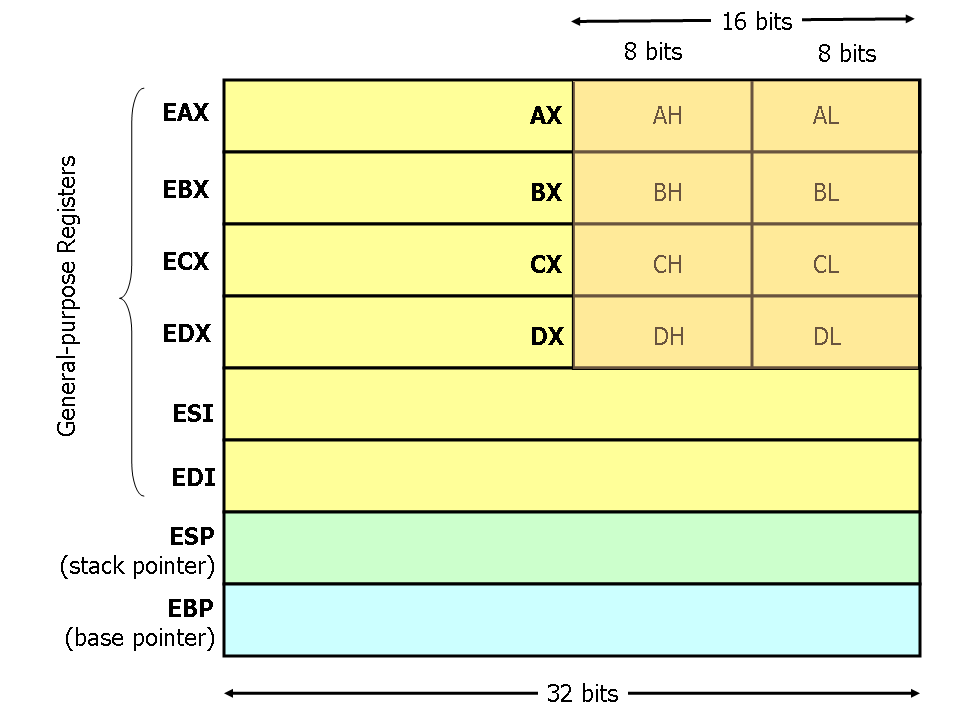
Credits to ‘Dvd848’ for writing a excellent guide for a similar question in 2018 Here
Calling asm3(0xc264bd5c,0xb5a06caa,0xad761175) >> move {0xc264bd5c} into [ebp+08], {0xb5a06caa} into [ebp+0c], {0xad761175} into [ebp+10]
This is how the stack looks like after performing the mov ebp,esp command:
'little-endian' (reverse form)
+---------------+ | +---------------+
| old ebp | <-- ebp | | old ebp | <-- ebp
+---------------+ | +---------------+
| ret | <-- ebp + 0x4 | | ret | <-- ebp + 0x4
+---------------+ | +---------------+
| 0xc264bd5c | <-- ebp + 0x8 (arg1) | | 5c|bd|64|c2 | <-- ebp + 0x8 (arg1)
+---------------+ | +---------------+
| 0xb5a06caa | <-- ebp + 0xc (arg2) | | aa|6c|a0|b5 | <-- ebp + 0xc (arg2)
+---------------+ | +---------------+
| 0xad761175 | <-- ebp + 0x10 (arg3) | | 75|11|76|ad | <-- ebp + 0x10 (arg3)
+---------------+ | +---------------+
And due to endianness (little-endian), this is how the stack looks like, relative to ebp:
Byte grouping:
+0x8 +0x9 +0xA +0xB +0xC +0xD +0xE +0xF +0x10 0x11 0x12 0x13
+----+----+----+----+----+----+----+----+----+----+----+----+
| 5c | bd | 64 | c2 | aa | 6c | a0 | b5 | 75 | 11 | 76 | ad |
+----+----+----+----+----+----+----+----+----+----+----+----+
<---------------------------read RTL-------------------------
Word grouping:
+0x8 +0xA +0xC +0xE +0x10 +0x12
+------+------+------+------+------+------+
| 52bd | 64c2 | aa6c | a0b5 | 7511 | 76ad |
+------+------+------+------+------+------+
<---------------read RTL-------------------
DWord grouping:
+0x8 +0xC +0x10
+----------+----------+----------+
| 52bd64c2 | aa6ca0b5 | 751176ad |
+----------+----------+----------+
<-------------read RTL------------
asm3: ; Description of Function
<+0>: push ebp ; function Prologue
<+1>: mov ebp,esp ; ~
<+3>: xor eax,eax ; faster way of moving {0} into EAX
<+5>: mov ah,BYTE PTR [ebp+0x9] ; base on 'Byte grouping' [ebp+0x9] = {0xbd}, mov ah = {0xbd00}
<+8>: shl ax,0x10 ; sh1 (left shifts) by 0x10, result ax = 0
<+12>: sub al,BYTE PTR [ebp+0xd] ; sub al with BYTE [ebp+0xd] = {0x6c} = 0x0-0x6c=0x94 (1 bit overlow, 0x100-0x6c=0x94)
<+15>: add ah,BYTE PTR [ebp+0xf] ; add ah with BYTE [ebp+0xf] = {0xb5} = 0xb5, ax = {0xb594}
<+18>: xor ax,WORD PTR [ebp+0x10] ; Xor ax with WORD [ebp+0x10] = {0x1175} Read RTL = {0xb594 XOR 0x1175} = {0xa4e1} Correct Answer
<+22>: nop ; no operation
<+23>: pop ebp ; function Epilogue
<+24>: ret ; return
Flag
0xa4e1
asm4
Points: 400
Problem
What will asm4(“picoCTF_376ee”) return? Submit the flag as a hexadecimal value (starting with ‘0x’). NOTE: Your submission for this question will NOT be in the normal flag format. Source located in the directory at /problems/asm4_2_0932017a5f5efe2bc813afd0fe0603aa.
Hint
Treat the Array argument as a pointer
Solution
Credits to ‘xnand.netlify’ & ‘prasantadh’ for writing a excellent guide for a similar question in 2018 Here Or Here
An alternative approach is taken to resolve the problem. Instead of visualising the code line by line, the ASM code is converted to NASM (Netwide Assembler) code for direct execution. The process of converting includes
-
Removing of PTR from the ASM code.
mov DWORD PTR [ebp-0x10],0x25c >>> mov DWORD [ebp-0x10],0x25c -
Changing the jump address to labels
jmp 0x518 <asm4+27> >>> jmp part_b -
Added
section .text&globalon the header of the NASM file
ASM Code
asm4:
<+0>: push ebp
<+1>: mov ebp,esp
<+3>: push ebx
<+4>: sub esp,0x10
<+7>: mov DWORD PTR [ebp-0x10],0x25c
<+14>: mov DWORD PTR [ebp-0xc],0x0
<+21>: jmp 0x518 <asm4+27>
<+23>: add DWORD PTR [ebp-0xc],0x1
<+27>: mov edx,DWORD PTR [ebp-0xc]
<+30>: mov eax,DWORD PTR [ebp+0x8]
<+33>: add eax,edx
<+35>: movzx eax,BYTE PTR [eax]
<+38>: test al,al
<+40>: jne 0x514 <asm4+23>
<+42>: mov DWORD PTR [ebp-0x8],0x1
<+49>: jmp 0x587 <asm4+138>
<+51>: mov edx,DWORD PTR [ebp-0x8]
<+54>: mov eax,DWORD PTR [ebp+0x8]
<+57>: add eax,edx
<+59>: movzx eax,BYTE PTR [eax]
<+62>: movsx edx,al
<+65>: mov eax,DWORD PTR [ebp-0x8]
<+68>: lea ecx,[eax-0x1]
<+71>: mov eax,DWORD PTR [ebp+0x8]
<+74>: add eax,ecx
<+76>: movzx eax,BYTE PTR [eax]
<+79>: movsx eax,al
<+82>: sub edx,eax
<+84>: mov eax,edx
<+86>: mov edx,eax
<+88>: mov eax,DWORD PTR [ebp-0x10]
<+91>: lea ebx,[edx+eax*1]
<+94>: mov eax,DWORD PTR [ebp-0x8]
<+97>: lea edx,[eax+0x1]
<+100>: mov eax,DWORD PTR [ebp+0x8]
<+103>: add eax,edx
<+105>: movzx eax,BYTE PTR [eax]
<+108>: movsx edx,al
<+111>: mov ecx,DWORD PTR [ebp-0x8]
<+114>: mov eax,DWORD PTR [ebp+0x8]
<+117>: add eax,ecx
<+119>: movzx eax,BYTE PTR [eax]
<+122>: movsx eax,al
<+125>: sub edx,eax
<+127>: mov eax,edx
<+129>: add eax,ebx
<+131>: mov DWORD PTR [ebp-0x10],eax
<+134>: add DWORD PTR [ebp-0x8],0x1
<+138>: mov eax,DWORD PTR [ebp-0xc]
<+141>: sub eax,0x1
<+144>: cmp DWORD PTR [ebp-0x8],eax
<+147>: jl 0x530 <asm4+51>
<+149>: mov eax,DWORD PTR [ebp-0x10]
<+152>: add esp,0x10
<+155>: pop ebx
<+156>: pop ebp
<+157>: ret
NASM Code (end_asm_rev.S)
section .text
global asm4
asm4:
push ebp
mov ebp,esp
push ebx
sub esp,0x10
mov DWORD [ebp-0x10],0x25c
mov DWORD [ebp-0xc],0x0
jmp part_b
part_c:
add DWORD [ebp-0xc],0x1
part_b:
mov edx,DWORD [ebp-0xc]
mov eax,DWORD [ebp+0x8]
add eax,edx
movzx eax,BYTE [eax]
test al,al
jne part_c
mov DWORD [ebp-0x8],0x1
jmp part_d
part_e:
mov edx,DWORD [ebp-0x8]
mov eax,DWORD [ebp+0x8]
add eax,edx
movzx eax,BYTE [eax]
movsx edx,al
mov eax,DWORD [ebp-0x8]
lea ecx,[eax-0x1]
mov eax,DWORD [ebp+0x8]
add eax,ecx
movzx eax,BYTE [eax]
movsx eax,al
sub edx,eax
mov eax,edx
mov edx,eax
mov eax,DWORD [ebp-0x10]
lea ebx,[edx+eax*1]
mov eax,DWORD [ebp-0x8]
lea edx,[eax+0x1]
mov eax,DWORD [ebp+0x8]
add eax,edx
movzx eax,BYTE [eax]
movsx edx,al
mov ecx,DWORD [ebp-0x8]
mov eax,DWORD [ebp+0x8]
add eax,ecx
movzx eax,BYTE [eax]
movsx eax,al
sub edx,eax
mov eax,edx
add eax,ebx
mov DWORD [ebp-0x10],eax
add DWORD [ebp-0x8],0x1
part_d:
mov eax,DWORD [ebp-0xc]
sub eax,0x1
cmp DWORD [ebp-0x8],eax
jl part_e
mov eax,DWORD [ebp-0x10]
add esp,0x10
pop ebx
pop ebp
ret
C Code (solution.c)
Next is to write a C program that uses the exported library:
#include <stdio.h>
extern int asm4(char a[]);
int main(void) {
char a[]="picoCTF_376ee";
printf("0x%x\n", asm4(a));
return 0;
}
Compile the prgram as seen below :
‘nasm -f elf32 end_asm_rev.S -o end_asm_rev.o’
‘gcc solution.c end_asm_rev.o -o solution -m32’
Lastly, Run the program as following :
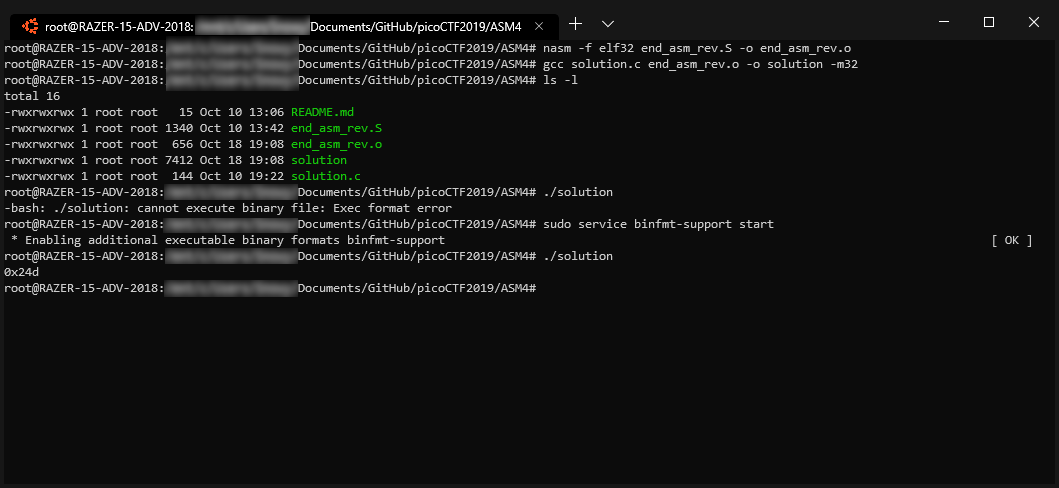
Troubleshooting
If an error is return during the execution of the solution file :
‘cannot execute binary file: Exec format error’ Error
You may follow this solution to resolve the error from Froosh @ Here
Flag
0x24d
Method 2 for ASM1
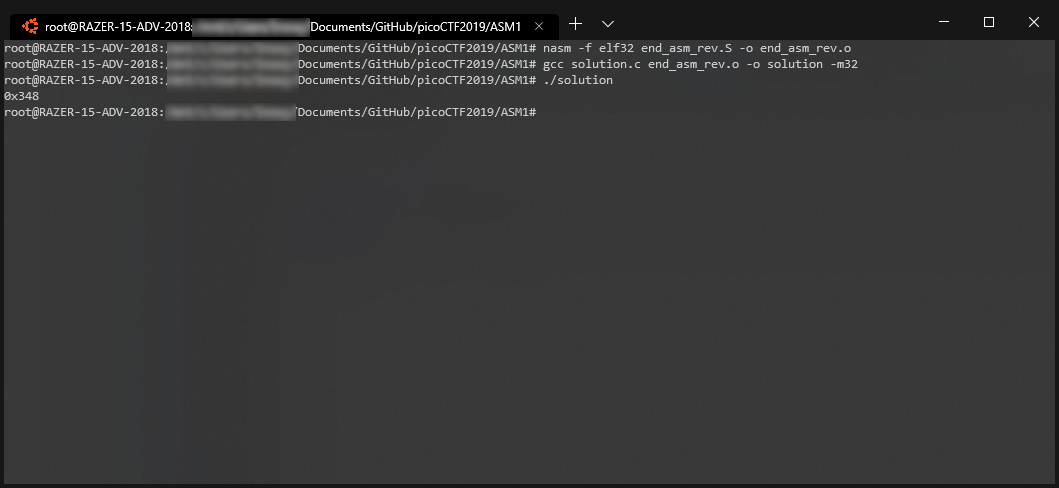
NASM Code (end_asm_rev.S)
section .text
global asm1
asm1:
push ebp
mov ebp,esp
cmp DWORD [ebp+0x8],0x37a
jg part_a
cmp DWORD [ebp+0x8],0x345
jne part_b
mov eax,DWORD [ebp+0x8]
add eax,0x3
jmp part_c
part_b:
mov eax,DWORD [ebp+0x8]
sub eax,0x3
jmp part_c
part_a:
cmp DWORD [ebp+0x8],0x5ff
jne part_d
mov eax,DWORD [ebp+0x8]
sub eax,0x3
jmp part_c
part_d:
mov eax,DWORD [ebp+0x8]
add eax,0x3
part_c:
pop ebp
ret
C Code (solution.c)
#include <stdio.h>
extern int asm1(int a);
int main(void) {
printf("0x%x\n", asm1(0x345));
return 0;
}
Method 2 for ASM2
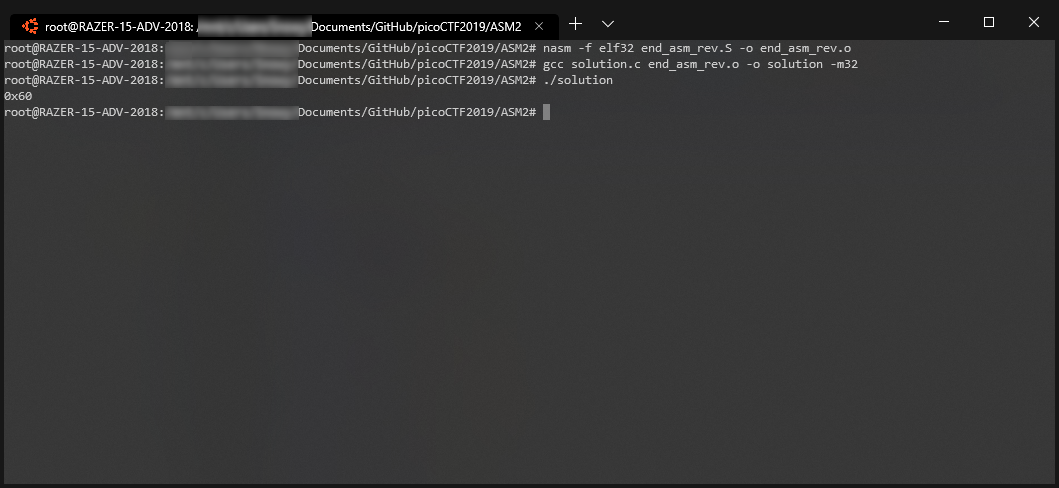
NASM Code (end_asm_rev.S)
section .text
global asm2
asm2:
push ebp
mov ebp,esp
sub esp,0x10
mov eax,DWORD [ebp+0xc]
mov DWORD [ebp-0x4],eax
mov eax,DWORD [ebp+0x8]
mov DWORD [ebp-0x8],eax
jmp part_a
part_b:
add DWORD [ebp-0x4],0x1
add DWORD [ebp-0x8],0xcc
part_a:
cmp DWORD [ebp-0x8],0x3937
jle part_b
mov eax,DWORD [ebp-0x4]
leave
ret
C Code (solution.c)
#include <stdio.h>
extern int asm2(int a, int b);
int main(void) {
printf("0x%x\n", asm2(0x7,0x18));
return 0;
}
Method 2 for ASM3
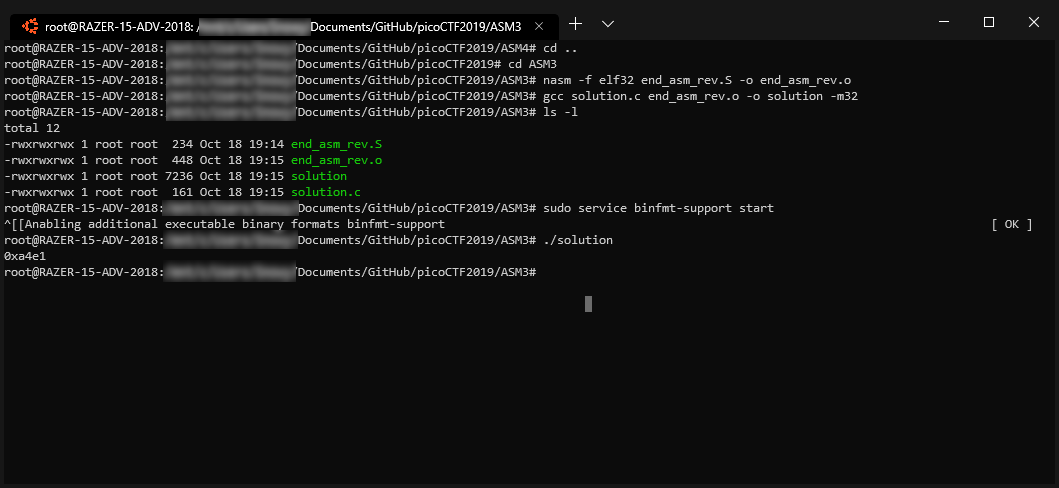
NASM Code (end_asm_rev.S)
section .text
global asm3
asm3:
push ebp
mov ebp,esp
xor eax,eax
mov ah,BYTE [ebp+0x9]
shl ax,0x10
sub al,BYTE [ebp+0xd]
add ah,BYTE [ebp+0xf]
xor ax,WORD [ebp+0x10]
nop
pop ebp
ret
C Code (solution.c)
#include <stdio.h>
extern int asm3(int a, int b, int c);
int main(void) {
printf("0x%x\n", asm3(0xc264bd5c,0xb5a06caa,0xad761175));
return 0;
}